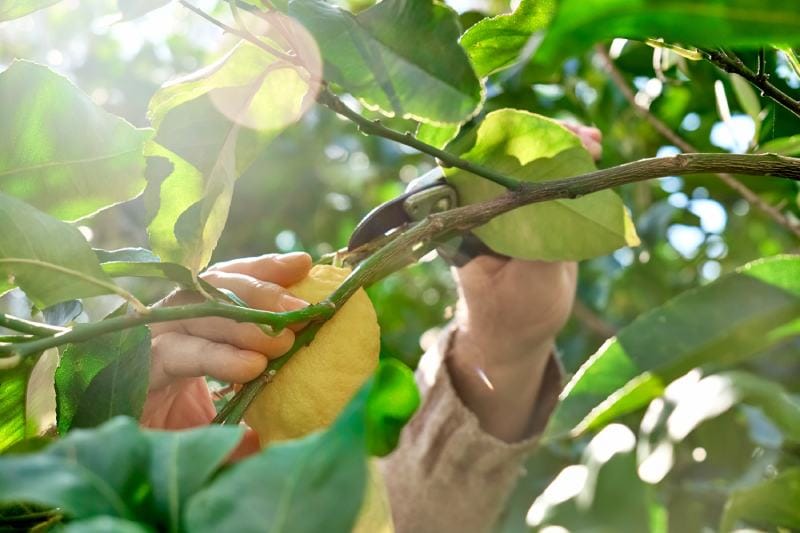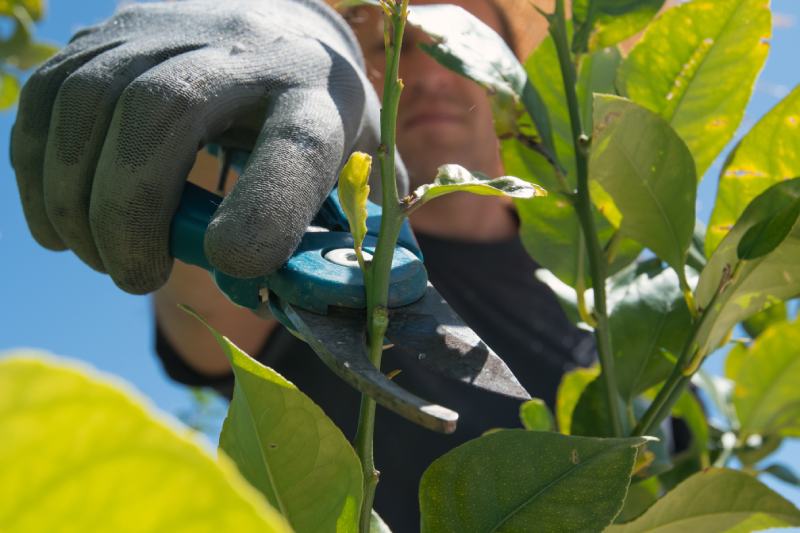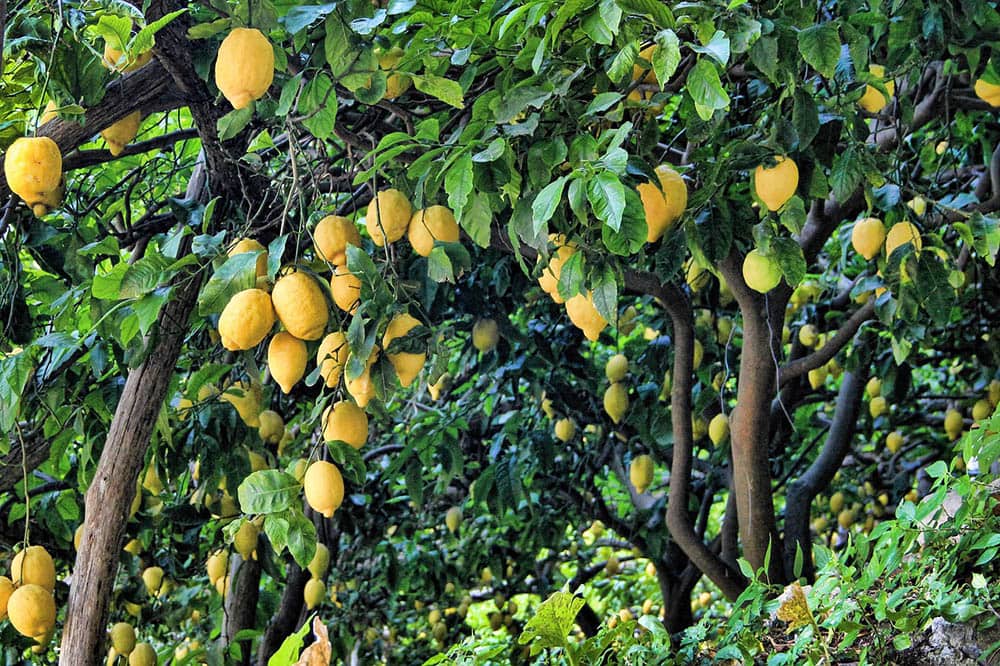8 Tips on When & How to Prune Lemon Trees
-
Pete Ortiz
- Last updated:

If you’ve always wanted to add more trees to your backyard garden, go for the lemon species. Other than the fact that their small-to-medium size structures make them suitable for limited spaces, they also happen to be rich in several essential minerals. The kind of minerals that your body needs to fight conditions such as high blood pressure and diabetes.
To be clear, we’re not saying that lemons are the panacea for all the diseases known to man. All we’re saying is, your immune system needs potassium, vitamin C, antioxidants, proteins, and iron, to reinforce its defenses, and keep such illnesses at bay.
Once you’ve grown your lemons, you’ll have to prune them from time to time. Pruning is a maintenance practice that involves the removal of certain branches for one reason or the other. You could prune your trees to encourage fruit production, prevent the spread of diseases, or make the space aesthetically appealing.
Unfortunately, this is no easy task. And what makes it even harder is that there are a limited number of information sources that explain how the whole process needs to be carried out. Read on below to find out more.
The 8 Pruning Tips for Your Lemon Tree
1. Prune Right After Planting

Before we get to the pruning bit, you have to understand that the planting procedure is of paramount importance. You cannot plant the tree the same way you plant any other species and expect it to thrive. It has to be slightly higher than the ground, meaning the hole that you’ll be digging has to be relatively shallow.
If you place the plant inside and notice that all of the root ball section is disappearing into it, that hole is way too deep. Shovel some of the soil back in before placing the plant.
Once you’re done, cover it with the remaining soil, and then water sufficiently. We also like to add a little mulch just to make sure that most of that moisture gets retained and doesn’t dry out. Mulch can be anything, ranging from organic matter such as dead plants to inorganic substances such as landscape fabric.
And now comes the pruning part.
You’ll be required to prune your young plant to encourage lemon production and mitigate the effects of stress and shock. And yes, plants do die from shock and stress. The onset signs are sudden flower loss, yellowing of the leaves, stunted growth, and even wilting. How far back should you prune it? You’ll have to chop roughly half of it.
2. Prune On the First Day of Winter
From our experience, spring is the best time to plant this species. We noted that it doesn’t do well under harsh conditions, especially the kind that characterize summer and winter. Then again, its survival also depends on the growing zone or region. We have gardeners who’ve managed to plant them during summer, and they survived. Others did during spring and still got disappointed.
But let’s assume you planted yours during spring and followed the instructions to the tee. You pruned it immediately after and are now wondering when the next session should be. Well, it’s during the first day of winter. And you’re required to prune all the branches, save for 4 or 5.
The worst mistake that you could make is to cut all branches and forget to leave some behind. This tree species always needs a few of those to act as fruiting branches. We often prune most of the branches during winter to help the tree focus on producing quality fruits.
It’s also worth mentioning that the lemon tree species tends to produce more fruits when it has fewer branches because it’s easier for sunlight to penetrate and get to all branches. Light is an essential requirement for photosynthesis (their food production process) and proper fruit color development.
3. Prune Annually

Did you know the average lifespan of a lemon tree is 50 years? But to clock those 50 long years, you have to ensure that it stays healthy. Staying healthy means you have to prune it annually to hinder the growth of bacteria or the spread of various diseases.
We know it all sounds counterproductive, but if you don’t find a way to thin out that tree soon, no amount of sunlight will be able to get to its lower branches. Thus, creating an environment that makes them susceptible to bacteria and other disease-causing vectors.
It’s easy to tell if your lemon tree is healthy or not, by observing its life cycle. Ordinarily, it takes 2 to 5 years to bloom. Each branch will have a male and female flower, waiting for a primary pollinator (the bee) to start working. If you’ve never seen a single fruit in 6 years, you either did something wrong while planting or didn’t bother to prune the tree.
Also, all lemon trees should be pruned during the dormant season. And don’t forget that consistency is key to their survival.
4. Don’t Prune the Outward-Pointing Branches
There’s always a method to every madness. And in this case, you only get to prune the branches that are horizontal to the fruiting branches and those that are growing inwards. By “inwards” we mean those that are pointed toward the ground.
The branches that are growing outwards will bear flowers that have easier access to sunlight. Those that are horizontal or those pointing inwards, won’t be able to get the required amount of light to produce quality fruits or any fruit at all. Therefore, they are essentially useless.
5. Chop Off All of The Dead Wood

Dead branches are practically dead weight to the tree. You won’t hear them complain, but they’ll be struggling to transport nutrients to sections that need them most. There’s also the energy factor that you have to consider. It’s been proven that all living organisms need energy for various reasons.
To plants, that energy is vital for the growth, reproduction, and maintenance of their structures. For that reason, if you don’t prune all the dead branches, more of the chemical energy stored in the plant’s molecules will be consumed while it fights to revive them.
And the same should be done to branches that are discolored, diseased, or bark-less.
6. Don’t Forget the Suckers
Have you ever wondered why some tree species look exactly like shrubs even though they have no relation? That’s because they grow branches called suckers. A sucker is basically a stem, but one that grows from the base of a tree, or at a spot on its trunk.
We often call them suckers due to the fact that they suck most of the water and nutrients from the plant and provide nothing in return. The best time to prune a sucker is while it’s still at a developmental stage. And if you’re going to chop it off, target the base.
Whether or not they grow back depends on the cause. If they were caused by pests or diseases, the chances of growing back are slim to none. But if you keep subjecting the plant to more stress, it certainly will.
7. Remove the Secondary Branches

You must have realized by now that the ultimate goal is to ensure the tree has very few branches all year round. And achieving this goal will feel taxing if you keep letting the secondary branches grow untamed.
By definition, a secondary branch is any branch that’s growing off a prime/primary/main branch. If left unchecked, they’ll occupy all the spaces and pathways used by sunlight to get to the lower branches. In other words, the lower fruit-bearing branches won’t get adequate light to produce quality fruits.
8. Prune Parts of the Prime Branches
For the tree to produce more fruits, we need the fruiting branches to keep on growing. And the only way to activate those cells is to prune a third or a quarter of the branch. This move will undoubtedly promote growth and facilitate the production of more fruits.
Pruning fruiting branches is also meant to guarantee that all branches are at least 12 inches apart and that none of them are intertwined.
Frequently Asked Questions

Are Lemon Trees Susceptible to Pests?
Unfortunately, yes. They are often attacked by gastropods, caterpillars, rodents, and insects. These pests will attack any part of the plant, including the branches, stems, fruits, and leaves. If you fail to address the situation before it gets out of hand, the tree will start showing signs of stunted growth and the leaves will gradually fall.
How Do You Get Rid of the Pests That Usually Plague Lemon Trees?
We’ve used oil sprays before and found them to be very effective. Especially the horticultural oil spray that’s environmentally friendly, and common among gardeners looking to eliminate mealybugs, spider mites, white flies, and aphids.
We’d 100% recommend this spray, as it’s not toxic to any animal or bird, and leaves zero residues behind. You’ll also be glad to learn that it doesn’t kill beneficial insects such as bees, that help in pollination.
Should We Cover Our Lemon Trees?
It’s no news that the lemon species don’t do well under extreme conditions—both hot and cold. So, if you’ve noticed that the temperatures have dropped to units that are way below 29ºF, and there are no signs of improvement, start looking for a cover.
In Conclusion
Providing fruits and ensuring you get the minerals that your body requires to fight various diseases is not the only function of a lemon tree. Just like any other tree species, this plant plays a critical role in guaranteeing that our communities are safe and more connected.
They’ll help clean your air, prevent heat-related deaths (by providing a cool environment), and slow down flooding as well as storm surges. So, take care of them, if you want them to take care of you.
Featured Image Credit: Iryna Inshyna, Shutterstock
Contents



